Using the simulation below and the instructions available you need to complete the data table in your book and answer questions 1-8 in your books. Some of the questions can be completed in the analysis data table. If you wish to complete the questions on the word document, ensure it is printed and stuck neatly in your book.
This is due for the 1st Monday you come back from half term: Monday 2nd June.
Any queries you have, use the comments box below or the twitter feed on the right hand side navigation bar (@SMAchemist). Instructions document is available by clicking on the link.
Hint: Remember salt is NaCl and so is an example of an ionic compound. Sugar consists of carbon, oxygen and hydrogen (C6H12O6). All the elements are non-metals so sugar is an example of covalent bonding
Monday, 19 May 2014
Wednesday, 14 May 2014
Tuesday, 13 May 2014
"This is geography not chemistry" say all St. Margie's students about C1 chapter 7…..
Chemistry calculations reveal Earth's inner core | Chemistry World
Chemistry finds that there's lots of oxygen at the core of our planet but remember for your exam (C1) these key points:
Chemistry finds that there's lots of oxygen at the core of our planet but remember for your exam (C1) these key points:
- inner core: solid, very hot >6000 degrees celcius, lots of iron to cause magnetic field
- outercore molten, also very hot and also has loads of metal in it.
Gridlocks revision game for KS3, KS4 and KS5
For some variety in your revision you might like to try gridlocks which is a unique way to bolster some key terms and ideas. There are topics suitable for all age ranges and is ideal for those who like all thing Su Doku or problem solving.
First of all, you need to select a topic in your age bracket: Level 1 (11-14), level 2 (14-16) or level 3 (16-18).
In this example is level 2 acids. First of all, you need to match up the terms to the correct definitions. In this example, you have to match up the acid names to their formula and also to a salt formed when in reacts with sodium hydroxide (an alkali). This will act as a reference tool if you get stuck on the puzzles.
First of all, you need to select a topic in your age bracket: Level 1 (11-14), level 2 (14-16) or level 3 (16-18).
In this example is level 2 acids. First of all, you need to match up the terms to the correct definitions. In this example, you have to match up the acid names to their formula and also to a salt formed when in reacts with sodium hydroxide (an alkali). This will act as a reference tool if you get stuck on the puzzles.
Secondly you will be given three 'Su Doku' style puzzles to organise the different fields, in this instance we are using an example with the name and formula of the acids. The hydrochloric acid name cannot go in the same row or column as its formula, which in this case is HCl.
Post your times below to compare the tougher topics.
Monday, 12 May 2014
Build an atom interactive
Sunday, 11 May 2014
Excellent video playlist to help with revision
These videos are suitable for year 10 students and up. Covering a range of different topics, you can select from the drop down menu on the top left of the window.
Unit 3 booklet
This is aimed at 11.1 and 11.2 to help you revise before thursday's exam. You can pick activities to help you revise. There are guidelines to help you revise.
Unit 3 booklet part 1 covers: the periodic table, energy changes and water (Ch 1, 2 and 3)
Unit 3 booklet part 2 covers: analytical techniques and organic chemistry (Ch 4 and 5)
Click on the links to access the google drive to download these PDF files.
The first pages of each document are not applicable to you, but I have left them in as you may find them useful in directing your studies.
LDR
Unit 4 playlist
For year 13 eyes only. These overviews will give you a break from your usual revision style and you might pick up some useful tips or alternative methods. Any comments you may have, please leave below or contact via the twitter feed.
Subscribe to:
Comments (Atom)




